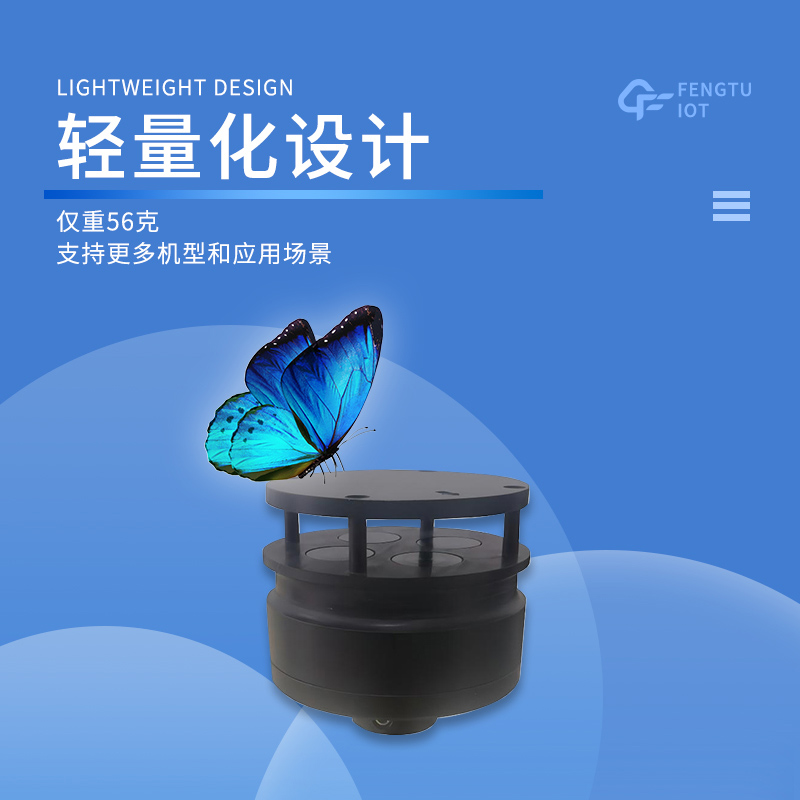Tianqiong Sensor IOT Technology Co., Ltd
Sales Manager:Ms. Emily Wang
Cel,Whatsapp,Wechat:+86 15898932201
Email:info@fengtutec.com
Add:No. 155 Optoelectronic Industry Accelerator, Gaoxin District, Weifang, Shandong, China

Sales Manager:Ms. Emily Wang
Cel,Whatsapp,Wechat:+86 15898932201
Email:info@fengtutec.com
Add:No. 155 Optoelectronic Industry Accelerator, Gaoxin District, Weifang, Shandong, China
time:2025-06-27 09:03:13 source:Weather Station viewed:190 time
The Anemometer for Drones FT-F1 is specially designed for low-altitude wind measurement by unmanned aerial vehicles (UAVs). With high precision, stability, and efficiency, it provides accurate data for meteorological research, agricultural and forestry monitoring, environmental surveying, and other applications.
Ultrasonic Wind Measurement Technology
FT-F1 adopts ultrasonic wind measurement technology, calculating wind speed and direction by measuring the time difference of ultrasonic waves propagating in the air. This non-mechanical measurement method avoids the accuracy degradation and failure issues caused by mechanical wear in traditional mechanical sensors, enhancing the instrument's service life and reliability. The core components of the instrument undergo strict screening and calibration, enabling stable operation in extreme temperature environments ranging from -40°C to 85°C. It adapts to complex climatic conditions such as deserts, plateaus, and coastal areas.
High-Precision Measurement Capabilities
Wind Speed: Measurement range of 0.3m/s to 60m/s with an accuracy of ±0.1m/s.
Wind Direction: Measurement range of 0° to 360° with an accuracy of ±3°.
Such high-precision data collection capabilities meet the fine-grained measurement requirements in low-altitude complex airflow environments. Equipped with a high-speed data processing chip, the instrument achieves a data refresh frequency of 10 times per second, real-time detecting dynamic changes in wind speed and direction. This provides timely and accurate data support for UAV flight safety assessment and mission planning.
Applications in Diverse Scenarios
Meteorological Emergency Monitoring: UAVs equipped with this instrument can quickly reach disaster sites to obtain real-time wind speed and direction data in areas difficult to cover by ground weather stations, providing key data for disaster early warning and rescue decision-making.
Agricultural and Forestry Plant Protection Operations: Accurate wind speed and direction data help optimize UAV spraying paths, reduce pesticide drift, and improve operation efficiency and effectiveness.
Seamless Integration and Efficient Operation
FT-F1 supports multiple communication protocols, enabling seamless docking with UAV flight control systems and ground data platforms for real-time data transmission and analysis.
The instrument’s efficiency is also reflected in its convenient installation and operation:
Lightweight Design: Weighing only 56g, it does not affect the UAV’s payload or battery life.
Plug-and-Play Interface: No complex debugging is required, allowing rapid deployment. It is also dustproof and waterproof.

The Photovoltaic Weather Station under Tianqiong enables precise, real-time, and continuous monitoring. Specifically designed for the photovoltaic industry, it accurately detects key meteorological parameters that affect photovoltaic power generation. In particular, regarding solar radiation, it can...
In an era where technological waves continue to surge and innovative achievements emerge endlessly, the public's environmental awareness has grown increasingly sophisticated, and their concern for ambient air quality has reached an unprecedented level. In the fast-paced modern life, as the inter...
In the production and use of photovoltaic modules, grid breakage is a relatively common and thorny problem. Grid breakage refers to the existence of breakpoints in the silver paste printing of the main grid of the solar cell, which causes the fine grid lines on the solar cell to be open-circuited wi...
With the booming development of ecotourism, scenic weather stations have become common devices in major tourist attractions and ecological parks (such as artificial wetlands, ecological parks, botanical gardens, etc.). It is dedicated to the all - day automatic online collection of air cleanliness i...